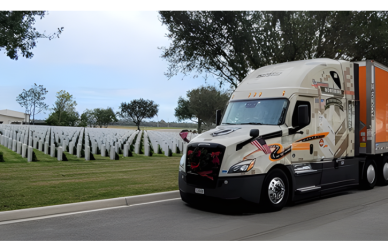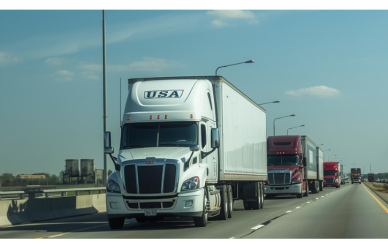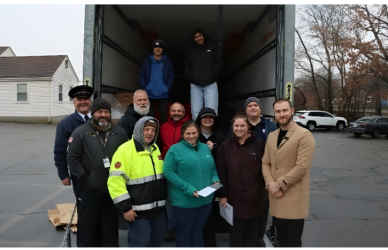Research conducted by the data science team at Verizon Connect in May 2023 has found that drivers who choose not to wear their seatbelts are more likely to be involved in accidents. The investigation, which analyzed over 7 million videos from Verizon Connect dashcam footage, revealed that commercial drivers operated vehicles without a seat belt fastened in 10% of instances.
Additionally, the study showed that 40% of these videos recorded vehicles exceeding the posted speed limit. This is concerning as speeding has been a significant factor in about one-third of all motor vehicle fatalities for the past 20 years. Furthermore, 64% of truck drivers killed in automobile accidents were not wearing seatbelts. These findings highlight the importance of wearing seatbelts for both personal safety and accident prevention.
“Generally, the driver’s actions that are captured most often are common occurrences like following the vehicle in front of you too closely and speeding. Drivers being unbelted is another action that we see quite often, especially as the detection systems surrounding unbelted drivers get more and more sophisticated,” said Kyle Warlick, a senior analyst in client intelligence at Lytx, a video telematics and fleet management solutions provider. “While driving unbelted has less of a direct relationship to collisions, as opposed to speeding and following too closely, we have seen that people who get into collisions often have been driving unbelted in the past. This is likely because drivers who are not engaging in safe driving by putting on their seatbelts are more likely to ignore other safety regulations.”
Verizon Connect has made improvements to its AI dashcam to enhance fleet management. The updated dashcam now includes new AI tags for detecting speeding and unfastened seat belts, providing additional context in each video. This allows fleet managers to analyze and prioritize harsh driving events more efficiently.
The Cloud AI video analytics engine from Verizon Connect offers further context, helping fleet managers identify and address immediate concerns without spending excessive time. Through Cloud AI analysis, fleet managers can easily view videos with severity labels and additional tags for tailgating, rolling stops, and phone distractions. By specifically identifying instances of speeding and unfastened seat belts, Verizon Connect empowers fleet managers to focus on coaching for better driving behaviors.
Gary Johnson, the head of safety and compliance strategy at Motive, a fleet management company, emphasizes the importance of regular updates and innovation in telematics systems. These updates help track and notify drivers and operators of unsafe driving behaviors, such as phone calls, texting, rolling stops, not using seat belts, and tailgating, which often lead to accidents and fatalities.
A recent study conducted by the Virginia Tech Transportation Institute compared Motive’s AI dashcam with two AI dashcams from other providers in the market. The study revealed that Motive’s AI dashcam outperformed the others, highlighting that the accuracy of AI systems can vary based on factors like camera placement and lighting conditions throughout the day.
“Accurate AI is crucial. Preventing the behaviors observed in the study is key to decreasing distracted driving accidents, which last year saw more U.S. pedestrians killed than at any other time in the last 40 years,” Johnson said. “… Accident prevention is made possible through risk detection that is both instant and precise. This can be the difference between preventing an accident and picking up the pieces after it happens. So things that drive these risk-detection behaviors and awareness are going to be key considerations.”
According to Idelic, seatbelt usage is not a high priority when it comes to assessing driver behavior. Brian Filip, Chief Technology Officer at Idelic, explains that while driver-facing cameras often capture instances of drivers not wearing seatbelts, Idelic does not heavily consider this factor in their scoring system for accident risk. Instead, they focus more on indicators such as drowsiness and phone usage, which are more commonly associated with accidents.
“I think from an overall risk mitigation perspective, I can’t think of any reason why a fleet carrier shouldn’t be very actively enforcing their seatbelt policy,” he said. “When I say that we don’t weight this heavily. We don’t weight it as heavily in terms of the likelihood that they will get into an accident. If you get into an accident, obviously having the seatbelt on is critical, but it doesn’t necessarily indicate that you’re more likely to get into an accident.”
Idelic enhances fleet safety by collecting and analyzing data from telematics sensors, cameras, FMCSA records, training data, and accident data. Through advanced machine learning models, the company identifies high-risk drivers who are likely to be involved in accidents within the next 90 days. In addition, Idelic offers coaching tools to help fleets mitigate risks.
Telematics providers are striving to improve their AI and machine learning capabilities to address unsafe driver behaviors. However, there are two key challenges. First, they lack comprehensive data visibility as they don’t have access to context from other sources such as FMCSA and accident data. Second, their focus is primarily on training rather than coaching, and they are trying to automate the coaching process using video to reduce the burden on back-office staff.
In terms of driver intervention, Filip, a representative from Idelic, believes that a more human-centered approach with less automation is more effective. This is why Idelic emphasizes the distinction between training and coaching.
“Training, we usually see that as more of a broad approach to serve all drivers with a baseline of knowledge. We see the training is often being used if there is a serious event being detected by the telematics provider … We always recommend to our customers that they should still be monitoring their telematics alerts dashboard every day for the serious events and that they should be immediately having conversations with the drivers about that specific event,” Filip said. “Where Idelic really helps is seeing the trends that aren’t as obvious from a single event and letting them know where the risk is associated with that. In those situations, we push more for coaching. Training is the giving of information in a manner that instructs a group or an individual. Coaching is a developmental approach to working with and interacting with those people. So training tends to be more of a one-way conversation: watch the video, read the PowerPoint, listen to the lecture. Whereas coaching is more of a two-way conversation. ‘Tell me what you’re doing in the cab. Why are you doing that? Do you understand this alternative? Have you tried this?’ It’s really interacting with the driver to try to have a greater impact.”
According to Warlick, Lytx has uncovered that a driver safety program is most effective when training and coaching are used in combination; however, the real deficiency lies in not having a dashcam or telematics system at all.
Source: CCJ Digital











